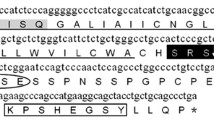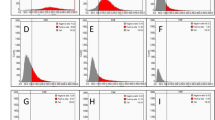Abstract
Obesity is a world-wide exponentially growing health problem that increases the risk of co-morbidities including metabolic syndrome, pre-diabetes, Type 2 Diabetes Mellitus (T2DM), and cancer. These co-morbidities are all complex conditions constituting a big challenge when searching for susceptibility genes. Identification of relevant genes, which could contribute to an earlier identification of individuals prone to develop diabetes, is urgently needed as many long-term complications can be avoided by preventive measures. Pre-diabetes is mainly associated with hyperglycemia; thus studying this phenotype might provide knowledge on relevant genes implicated in molecular mechanisms underlying pre-diabetes, and contributing to the development of T2DM. In the present study, two groups of pigs with high (HGG, N = 6) and low (NGG, N = 6) fasting plasma glucose level respectively were selected from a large pig population. Transcriptional levels of seven genes involved in the glucose transporter 4 (GLUT4) translocation pathway were studied by quantitative real-time PCR (qPCR) in diabetes relevant tissues (pancreas, adipose tissue, skeletal muscle, liver and kidney). Three of the genes, TBC (Tre-2, BUB2, CDC16) 1 Domain Family Member 4 (TBC1D4), insulin receptor and GLUT4 showed altered expression in some of the tissues. The expression pattern observed is in agreement with what has previously been reported in pre-diabetic humans confirming the pre-diabetic status of our pigs. Moreover, a novel isoform of TBC1D4 was detected by Western blotting using protein extracted from pancreas. The expression level of this novel isoform was further verified by qPCR in all tissues, showing the highest expression in the pancreas.


Similar content being viewed by others
References
Andersen CL, Jensen JL, Ørntoft TF (2004) Normalization of real-time quantitative reverse transcription-PCR data: a model-based variance estimation approach to identify genes suited for normalization applied to bladder and colon cancer data sets normalization of real-time quantitative reverse. Cancer Res 64:5245–5250. doi:10.1158/0008-5472.CAN-04-0496
Bianchin F, Kaaks R, Vainio H (2002) Overweight, obesity, and cancer risk. Lancet Oncol 3(9):565–574
Bouzakri K, Ribaux P, Alejandra T, Parnaud G, Rickenbach K, Halban PA (2008) Rab GTPase-activating protein AS160 is a major downstream effector of protein kinase B/Akt signaling in pancreatic Β-cells. Apoptosis 57:1195–1204. doi:10.2337/db07-1469.P.R
Butler AE, Juliette J, Bonner-Weir S, Ritzel R, Rizza RA, Butler PC (2003) Β-cell deficit and increased Β-cell apoptosis in humans with type 2. Diabetes 52:102–110
Cirera S (2013) Highly efficient method for isolation of total RNA from adipose tissue. BMC Res Notes 6:472. doi:10.1186/1756-0500-6-472
De Meyts P, Palsgaard J, Sajid W, Theede AM, Aladdin H (2004) Structural biology of insulin and IGF-1 receptors. Novartis Found Symp 262:160–171. doi:10.1038/nrd917 (discussion 171–76, 265–68)
Eguez L, Lee A, Chavez JA, Miinea CP, Kane S, Lienhard GE, McGraw TE (2005) Full intracellular retention of GLUT4 requires AS160 Rab GTPase activating protein. Cell Metab 2:263–272. doi:10.1016/j.cmet.2005.09.005
Hoehn KL, Hohnen-Behrens C, Cederberg A, Wu LE, Turner N, Yuasa T, Ebina Y, James DE (2008) IRS1-independent defects define major nodes of insulin resistance. Cell Metab 7:421–433. doi:10.1016/j.cmet.2008.04.005
Hribal M, Perego L, Lovari S, Andreozzi F, Menghini R, Perego C, Finzi G et al (2003) Chronic hyperglycemia impairs insulin secretion by affecting insulin receptor expression, splicing, and signaling in RIN beta cell line and human islets of langerhans. FASEB J 17:1340–1342. doi:10.1096/fj.02-0685fje
Imamura M, Maeda S (2011) Genetics of Type 2 diabetes: the GWAS era and future perspectives [review]. Endocr J 58(9):723–739. doi:10.1507/endocrj.EJ11-0113
Kogelman LJA, Kadarmideen HN, Mark T, Karlskov-Mortensen P, Bruun CS, Cirera S, Jacobsen MJ, Jørgensen CB, Fredholm M (2013) An F2 pig resource population as a model for genetic studies of obesity and obesity-related diseases in humans: design and genetic parameters. Front Genet 4:1–14. doi:10.3389/fgene.2013.00029
Kulkarni RN, Brüning JC, Winnay JN, Postic C, Magnuson MA, Kahn CR (1999) Tissue-specific knockout of the insulin receptor in pancreatic Β cells creates an insulin secretory defect similar to that in type 2 diabetes. Cell 96:329–339. doi:10.1016/S0092-8674(00)80546-2
Larance M, Ramm G, Stöckli J, Van Dam E, Winata S, Wasinger V, Simpson F et al (2005) Characterization of the role of the Rab GTPase-activating protein AS160 in insulin-regulated GLUT4 trafficking. J Biol Chem 280:37803–37813. doi:10.1074/jbc.M503897200
Leibiger B, Leibiger I, Moede T, Kemper S, Kulkarni R, Ronald Kahn C, Vargas L, Berggren P (2001) Selective insulin signaling through A and B insulin receptors regulates transcription of insulin and glucokinase genes in pancreatic beta Cells. Mol Cell 7:559–570. doi:10.1016/S1097-2765(01)00203-9
Minokoshi Y, Ronald Kahn C, Kahn B (2003) Tissue-specific ablation of the GLUT4 glucose transporter or the insulin receptor challenges assumptions about insulin action and glucose homeostasis. J Biol Chem 278:33609–33612. doi:10.1074/jbc.R300019200
Moltke I, Grarup N, Jørgensen M, Bjerregaard P, Treebak J, Fumagalli M, Korneliussen T et al (2014) A common greenlandic TBC1D4 variant confers muscle insulin resistance and type 2 diabetes. Nature. doi:10.1038/nature13425
Nygard A-B, Jørgensen C, Cirera S, Fredholm M (2007) Selection of reference genes for gene expression studies in pig tissues using SYBR green qPCR. BMC Mol Biol 8(January):67. doi:10.1186/1471-2199-8-67
Oliveira J, Rebuffat S, Gasa R, Gomis R (2014) Targeting type 2 diabetes: lessons from a Knockout model of insulin receptor substrate 2. NRP Res Press 620(June):613–620
Pant SD, Karlskov-Mortensen P, Jacobsen MJ, Cirera S, Kogelman LJA, Bruun CS, Mark T, Jørgensen CB, Grarup N, Appel EVR, Galjatovic EAA, Hansen T, Pedersen O, Guerin M, Huby T, Lesnik P, Meuwissen THE, Kadarmideen HN, Fredholm M (in press) Comparative analyses of QTLs influencing obesity and metabolic phenotypes in pigs and humans. PLoS ONE
Postic C, Leturque A, Rencurel F, Printz R, Forest C, Granner D, Girard J (1993) The effects of hyperinsulinemia and hyperglycemia on GLUT4 and hexokinase II mRNA and protein in rat skeletal muscle and adipose tissue. Diabetes 42(June):922–929. doi:10.2337/diabetes.42.6.922
Scott M, Grundy MD (2012) Pre-diabetes, metabolic syndrome, and cardiovascular risk. J Am Coll Cardiol 59(7):635–643. doi:10.1016/j.jacc.2011.08.080
Tan S-X, Ng Y, Burchfield JG, Ramm G, Lambright DG, Stockli J, James DE (2012) The RabGAP TBC1D4/AS160 Contains an atypical PTB domain that interacts with plasma membrane phospholipids to facilitate GLUT4 trafficking in adipocytes. Mol Cell Biol. doi:10.1128/MCB.00761-12
Whittaker J, Sørensen H, Gadsbøll V, Hinrichsen J (2002) Comparison of the functional insulin binding epitopes of the A and B isoforms of the insulin receptor. J Biol Chem 277(49):47380–47384. doi:10.1074/jbc.M208371200
Acknowledgments
We would like to thank Christel Ammitzböll Halberg and Minna Jakobsen for their assistance with RNA isolation and DNase treatment. We would also like to thank all the people involved in the generation, phenotypic measurements, and slaughtering of the F2 pig population. This study was supported by The Danish Independent Research Council Grant Number DFF 1335-00127.
Author information
Authors and Affiliations
Corresponding author
Electronic supplementary material
Below is the link to the electronic supplementary material.
Rights and permissions
About this article
Cite this article
Kristensen, T., Fredholm, M. & Cirera, S. Expression study of GLUT4 translocation-related genes in a porcine pre-diabetic model. Mamm Genome 26, 650–657 (2015). https://doi.org/10.1007/s00335-015-9601-z
Received:
Accepted:
Published:
Issue Date:
DOI: https://doi.org/10.1007/s00335-015-9601-z




